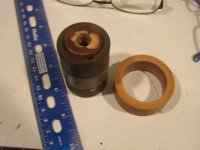I have an Elmco lathe that is part of a testing station. It is the 34A and has really interesting variable speed system where you can move a friction plate along the radius of a cast plate on the motor and increase or decrease the speed on the spindle. It has the original table and motor still and the tachometer so you can see how fast your a spinamathinging. You can see more detail about it here: Elmco Lathe and Electrical Test Stand
The issue I am trying to solve is that the friction disc is old and has been exposed to grease and dust over the years and looks like it needs to be replaced. It appears to be made of thin paper or cardboard rounds stacked up and bolted together. Has anybody seen something like this before or have an idea of how to replace. Only info I am finding is related to snowblowers and lawnmowers. I could replace it with something rubber perhaps?


The issue I am trying to solve is that the friction disc is old and has been exposed to grease and dust over the years and looks like it needs to be replaced. It appears to be made of thin paper or cardboard rounds stacked up and bolted together. Has anybody seen something like this before or have an idea of how to replace. Only info I am finding is related to snowblowers and lawnmowers. I could replace it with something rubber perhaps?







